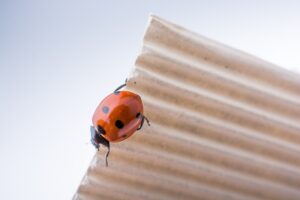Ladybugs — also known as lady beetles or ladybirds — play a crucial role in controlling pests like aphids in gardens and agricultural fields. Most ladybug adults and their alligator-looking larvae eat aphids, although the larvae are capable of eating far more aphids. Many of the various types of lady beetles in Western Canada are beneficial, but some are invasive and can be crop pests. Knowing how to identify these beetles can help you distinguish between friend and foe in your garden or home.
Asian lady beetle (Harmonia axyridis)
The Asian lady beetle might resemble native lady beetles, but in fact, it’s an invasive species. They were brought to the USA throughout the 20th century to control aphids and other crop-eating insects and spread into Canada in the 1990s, out-competing many native species such as the nine-spotted ladybug. The adults can damage fruit crops. The adult beetles are commonly found to be red with black spots, but their variable appearance ranges from light yellow to mostly black with spots ranging from none to more than 18. Compared to other ladybugs, these beetles are usually larger, have white on the centre of their faces, and have white areas behind their heads with black spots that join or almost-join into a shape like the letter ‘M’ (or ‘W’). Unlike native ladybugs that overwinter under leaves, rocks, and bark, Asian lady beetles are known for overwintering in homes and businesses. Asian lady beetles can deliver a painful bite and will often release a staining, yellow defensive compound when disturbed.
Seven-spotted ladybug (Coccinella septempunctata)
One of the most recognizable invasive lady beetles in Western Canada is the seven-spotted ladybug. True to its name, it typically features seven black spots on its red, oval-shaped body. This species made its way into Canada after being introduced into the USA in the 1970s. This ladybug is a valuable garden helper, voraciously consuming aphids, mealybugs and other garden pests. Identifying them is relatively easy because of their distinctive spots and colouration.
Two-spotted lady beetle (Adalia bipunctata)
The two-spotted lady beetle is a native species found in Western Canada with declining numbers. It prefers to live on trees and shrubs. The typical form has two black spots on its orange or red wing covers and a black thorax with white edge. Like the Asian lady beetle, the two-spotted lady beetle has variable forms and can range from orange to black with zero to fourteen spots. Unlike the Asian lady beetle, the centre of this beetle’s face is black. These beneficial insects also feed on aphids, scale insects, and mites, making them valuable allies in natural pest control.
Convergent lady beetle (Hippodamia convergens)
The convergent lady beetle is a native species that can vary in the number of spots on its back but will never have more than 13. They also often have a white margin around two distinct white lines converging on their thorax, which can help in identification. Like other lady beetles, they are beneficial predators, targeting aphids and other soft-bodied insects.
Twenty-spotted lady beetle (Psyllobora vigintimaculata)
The twenty-spotted lady beetle, as the name suggests, can have up to twenty spots on its white to light-tan body. These tiny lady beetles are native to Western Canada and are often found in forests. Unlike many other lady beetles, they mostly feed on fungus and powdery mildew found on the leaves of plants, especially skunk cabbage.
Insect control in Western Canada
At Poulin’s Pest Control, we specialize in commercial and residential insect control. If you have a problem with Asian lady beetles, cockroaches, or wasps, our technicians will get to the source of the infestation and eliminate them. Contact us today to schedule a site inspection for your home or business.

